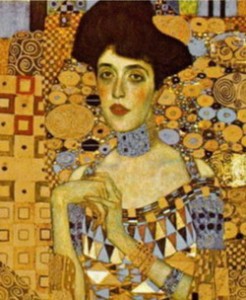Pinky says: continuation of Bloch-Bauer Portrait
According to the Belvedere Gallery Adele had bequeathed the Klimt paintings to the gallery. It was not until the late 1990s that the ugly twisted saga of Vienna’s acquisition of the Klimts began to unfold. In 1998 Austria joined other countries in signing an agreement to examine the provenance of its museum collections. The effort was finally going to be made to return stolen works to their owners. Federal archives were opened to the public. And so once confidential records now revealed how the Bloch-Bauer Klimts became the property of the Belvedere. The paintings had been stolen not once but three times–first by the Nazis and then twice by the Austrians. A series of articles exposed the scandal and crucial evidence came out about Adele’s will. Belvedere officials had insisted that Adele had bequeathed the works to the gallery. Maria Altmann’s lawyer had asked to see the will of Adele but was repeatedly fobbed off with excuses that it was mislaid. Ignoring the injustices suffered by Holocaust survivors was an accepted form of procedure. By barring the export of works of national heritage, the Austrian government was able to blackmail many refugees living abroad into surrendering valuable property. Claimants could get export permits for works of art only by letting the state retain its choice of many of their most valuable items. The lawyer and his clients had to “donate” the Klimts to the Belvedere before they could begin to reclaim minor remnants of Ferdinand’s collection. The government made threats and false assertions that the gallery had a right to the pictures under Adele’s will. But actually Adele’s will was not legally binding; she was leaving all her property to her husband and she only requested that he might leave the Klimts to the gallery after his death. The works had been commissioned and paid or by Ferdinand and were really his property. Actually he probably would want the gallery to have the works in 1925, but he most certainly did not want the portraits to go to Austria after the Anschluss. There is no doubt that he wanted his relatives to inherit the works. The confiscation of all his property and his exile by the Nazis and Austria had left him virtually penniless.
The paper trail of all seven Klimts shows that they passed through the hands of a Nazi lawyer appointed by the Gestapo to liquidate Ferdinand’s property. In 1941 the Fuehrer gave the portrait to the Belvedere with a note signed “Heil Hitler”. The lawyer dispensed the Klimts to various museums in Vienna. Adele’s golden portrait was Aryanised; its new title was Woman of Gold. Maria Altmann was most upset when she found out that the director of the Belvedere knew even during the Nazi era an incontestable declaration of gift in favor of the state was never obtained from Ferdinand. The new director of the Belvedere wrote to the former director “the situation is growing into a sea snake…I hope you can get me out of this not undangerous situation.” Even during the Nazi era an incontestable declaration of a gift in favor of the state was never obtained from Ferdinand. And so when Maria and her lawyer put the claim to Austria they felt that it was an unanswerable claim both legally and morally; yet the claim was turned down. Austria’s culture minister stated publicly that the Klimts were not stolen. Maria’s anger made the decision for her that they would now take the case through the US courts. It took seven years for her lawyer to finally win the case of Altmann vs the Republic of Austria. The Austrian government case was rejected by the courts. Altman’s victory was a bad day for Austria. They had gone to astonishing lengths to prevent the return of the Bloch-Bauer Klimts, which they had treated as their own national patrimony. It was a bitter blow to their pride and heritage.
Shortly after the decision there was controversy again when Maria sold Adele to Ronald Lauder for $135,000,000.00. Comments were made that this decision made her a money greedy person. She has said that the painting has no place in a private home and Lauder has placed it in the Neue Gallerie for the world to see. The art critic of the New York Times accused her of “cashing in” and thus “transforming” a story about justice and redemption after the Holocaust into yet another tale of the crazy and intoxicating art market. He argued they should give the works away to a public institution. Lauder says that Adele is “our Mona Lisa”. When he was ambassador to Austria he was involved in the case on the behalf of Maria Altmann. There is still anger and resentment in Austria over the loss of this great portion of their cultural possessions. To some Adele represents the need for a more reform and efficient means of handing over these works; to others it exemplifies the need to close the door on this chapter and suspend the process of restitution altogether. During Hitler’s reign more than 650,000 art works were looted or confiscated from their Jewish owners, but most of these were not valuable. They were mainly sentimental and symbolic. But today Adele reigns in a museum that we would like to think would have been her choice of final residence.



Leave a Reply